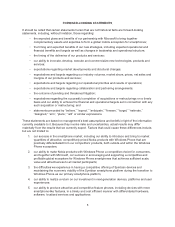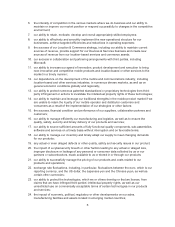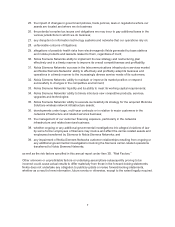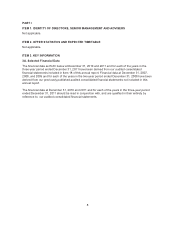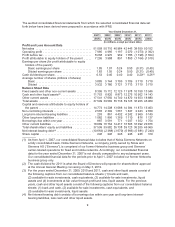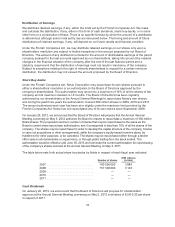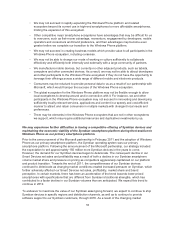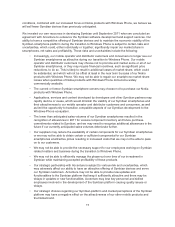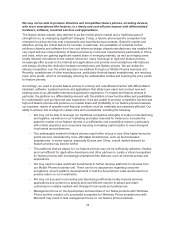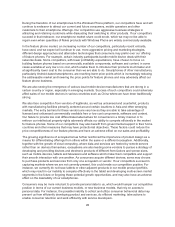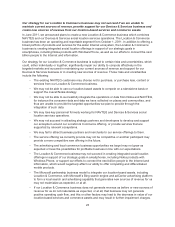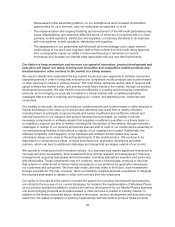Nokia 2011 Annual Report Download - page 17
Download and view the complete annual report
Please find page 17 of the 2011 Nokia annual report below. You can navigate through the pages in the report by either clicking on the pages listed below, or by using the keyword search tool below to find specific information within the annual report.• In choosing to adopt Windows Phone as our primary smartphone platform, we may forgo
more competitive alternatives achieving greater and faster acceptance in the smartphone
market. If the benefits of the Microsoft partnership do not materialize as expected, more
competitive alternatives may not be available to us in a timely manner, or at all.
• We manufacture mobile devices, but currently no other adjacent products, such as tablets,
computers and other connected devices. As a result, Nokia products with Windows Phone
may be a less compelling choice for consumers who wish to purchase multiple mobile
products from the same manufacturer or with the same or compatible operating system in
order to facilitate a smooth interaction among mobile products and electronic products of
different types and screen sizes, such as mobile devices, tablets, computers and televisions.
We may not be able to make Nokia products with Windows Phone a competitive choice for
consumers unless, together with Microsoft, we successfully encourage and support a
competitive and profitable global ecosystem for Windows Phone smartphones that achieves
sufficient scale, value and attractiveness to all market participants.
The emergence of ecosystems in and around the mobile device market for smartphones represents
the broad convergence of the mobile communication, computing, consumer electronics and Internet
industries. Different industry participants, such as hardware manufacturers, software providers,
developers, publishers, entertainment providers, advertisers and ecommerce specialists, are forming
increasingly large communities of mutually beneficial partnerships in order to bring their offerings to the
market. At the heart of the major smartphone ecosystems is the operating system and the
development platform upon which smartphones are based and services built. In February 2011, we
announced our partnership with Microsoft and adopted Windows Phone as our primary smartphone
platform designed to build a competitive global mobile ecosystem for our smartphones.
The creation of an ecosystem for Windows Phone smartphones that receives acceptance from
contributing parties and reaches sufficient scale is critical to making our Nokia products with Windows
Phone a competitive choice. If a successful Windows Phone ecosystem does not materialize in a
timely manner, this would have a material adverse affect on sales of our Nokia products with Windows
Phone and our profitability and otherwise significantly impair our ability to compete effectively in the
smartphone market. The principal risks and challenges that could prevent the creation of a successful
ecosystem for Nokia Windows Phones include the following:
• The Windows Phone platform may not achieve or retain broad or timely market acceptance or
be preferred by ecosystem participants, mobile operators and consumers.
• If we are not successful in our partnership with Microsoft or the benefits of that partnership do
not materialize as expected, we may have limited our options to build a competitive
smartphone ecosystem with another partner or join another competitive smartphone
ecosystem in a timely or economically profitable manner.
• We may not be able to develop and execute with speed sufficient quantities of high-quality
differentiated Nokia products with Windows Phone in order to achieve the scale needed for a
competitive global ecosystem.
• Applicable developer tools for the Windows Phone platform may not gain needed traction or
acceptance in the market, may be introduced late, or when introduced, may not offer
technologies that developers are willing to use.
• We may not be able to provide sufficient opportunities to innovate and customize on the
Windows Phone platform in order to attract developers and other ecosystem participants
seeking to differentiate their offerings on our smartphones from those of our competitors.
15


